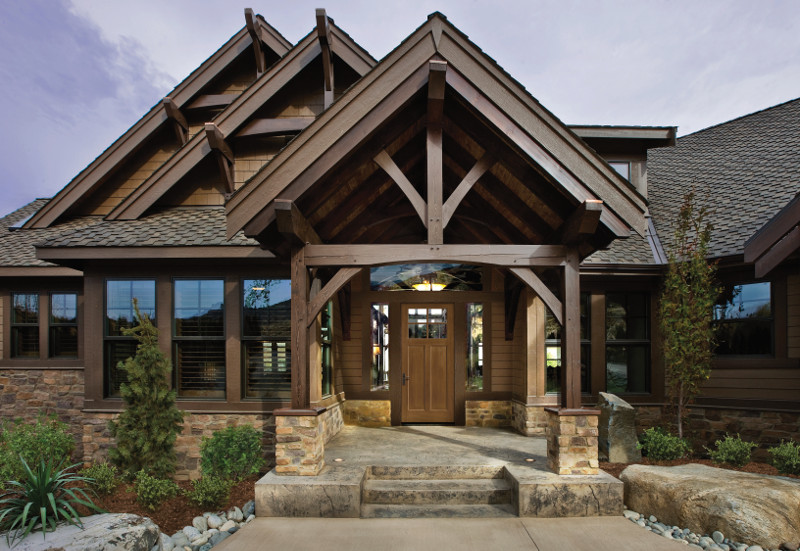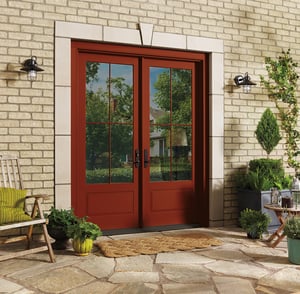Visit us at the Glass House Gallery located in the Indiana Design Center - Carmel, In

A front door does much more than add style to your home — though this is certainly valuable in and of itself! When you choose the right material for exterior doors, they increase energy efficiency and security as well. Since they play such a critical role in your home’s aesthetic and functioning, it’s important to choose wisely! So, let’s talk door materials.
Traditionally, doors came in one variety: wood. But as materials and technology evolve, we have an array of exceptional options from which to choose. Each has its own strengths and weaknesses; it’s important to weigh these, and consider your own needs and wants, when making your decision.
Today’s top performing exterior doors are constructed of:

In the past decade, fiberglass doors have undergone a revolution. Once similar in appearance to a fiberglass tub (nothing says “Welcome to my home,” like a bathtub!), top manufacturers can now replicate the look of wood.
Therma-Tru, for example, utilizes technology known as Accugrain to duplicate the grain of oak or mahogany such as in the image on the left from their Classic-Craft American Style Collection.
The benefits are twofold here: you achieve the look you want at about half the cost of real wood, and you avoid some troublesome issues, such as warping and twisting.
Wood is vulnerable to the elements: in humid weather, it swells. In cold weather, it contracts. Fiberglass provides the warmth and elegance of wood without these complications. Even better, they require virtually no maintenance. Unlike steel, for example, they are impervious to rust, and they help insulate your home when extreme temperatures hit.
A potential drawback is that you will pay more for high end fiberglass doors. While we’re starting to see some models at the entry level, the cost for quality doors is higher. If you opt for a fiberglass door that is not treated to mimic the look of wood, you can cut your costs.
Remember, though, with fiberglass doors, you’ll see a return on your investment in terms of value, durability, performance, security — and style!
Steel is a solid option, and these doors account for about half of the overall exterior door market. Their price is one reason. But there are others! Like fiberglass, steel delivers exceptional performance when it comes to energy efficiency and security.
They are also very low-maintenance; and because they resist cracking and warping, you can enjoy your investment for years to come. However, dents can be difficult to fix, and if you don’t take care of scratches promptly, rust can begin to creep up and spread.
When you choose steel, you can maximize your budget. But be sure to treat scratches as soon as possible so you don’t risk the integrity — and appearance — of your door. You also want to look for a lower gauge steel: a smaller gauge number equates to more steel.
Now, how about appearance? If you’re not into the industrial chic look, are you out of luck when it comes to steel exterior doors? Not today! Manufacturers like Provia offer woodgrain texture and 5-step stain finishing options so you can emulate the look of natural wood.

Don’t get the impression we’re picking on wood! This material has been an enduring favorite for centuries. It’s solid, it’s warm, it’s gorgeous. There’s a reason why other materials seek to emulate wood. The look and feel are the epitome of welcoming. They can also be good insulators against the elements if they have a solid engineered wood core.
But, as mentioned, wood contracts and swells with the weather, and this can lead to warping, rotting, and other damage. Your door may not close properly, or you may have to fight with it to open. Wood doors are also among the most expensive, especially if you opt for premium varieties like mahogany.
If you love wood, maintenance is essential, so you avoid issues with performance and appearance. Make sure to seal them before or immediately after installation to inhibit the absorption of moisture and reseal every few years. You’ll also want to touch up your stain or paint every few years to keep it looking its best. Sagging may be an issue as some of these doors are remarkably heavy: routine maintenance and updates to your frame and hardware are a must.
For all that work, however, you enjoy a gorgeous entry door that is stained or painted to suit your tastes. Many people prefer a natural stain to allow the beautiful grains of the wood to shine through.
Wood is easily customizable - a perk for those with non-standard sized doors and those who want a particular look (e.g. by installing glass inserts). We love wood; but make sure you’re ready to commit to maintenance and prepared to pay more in terms of initial costs.

Clad wood doors offer a solution for those who love the look of natural wood. These doors are constructed of wood, which remains visible on the inside of your home. The external-facing part of the door is covered with an aluminum clad shell to protect it from the elements. This gives you the durability you need and greatly reduces maintenance. It also provides you with endless design options.
From transoms to arches to extra-large sidelights, you can truly create the door you want. They generally feature full lite glass (one double or triple insulated glass pane) or lower panel and you can opt for energy efficient double pane Low E and Argon glass, privacy glass, or decorative glass.
Wood selection expands your options further. Pine is typically standard, but you can upgrade to mahogany, cherry, oak, or fir.
When it comes to the aluminum, you can often choose between extruded aluminum (about as thick as a quarter) or roll form aluminum (about as thick as a soda can). Extruded aluminum will cost more upfront, but you’ll enjoy greater longevity and durability.
Wood clad doors, however, are only available from companies (like Marvin) that manufacturer clad windows. They are made-to-order, so you will likely have a longer lead-time when ordering. Expect to wait four to six weeks or more, depending on the complexity of your needs.
Not sure which door material is the best choice for your home? Let us help with clear education and a hassle-free experience. Schedule a free in-home design consultation and the Franklin Window & Door team will take you through your options, show you samples, and help you select exterior doors that deliver the level of style and performance you need.
These Stories on Entry Door
200 S Rangeline Rd.
Suite 117
Carmel, Indiana 46032
Monday – Friday:
9am – 5pm
Evenings & Weekends:
By Appointment
Copyright © 2024 Franklin Window & Door. All Rights Reserved.
No Comments Yet
Let us know what you think